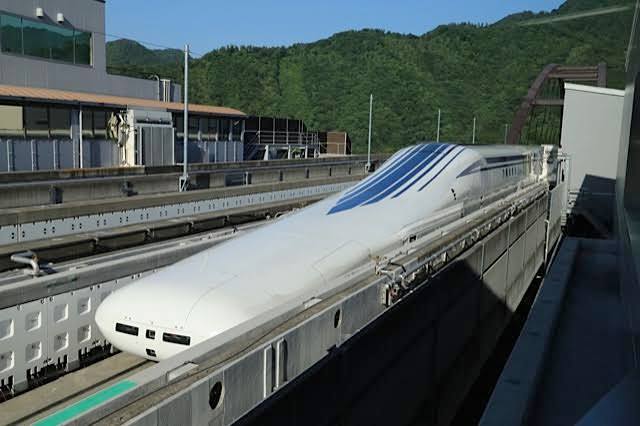Photo above: A maglev train in Japan below: On the train, from left, Gov. Larry Hogan, wife Yumi Hogan, Maryland Transportation Pete Rahn and Secretary of State John Wobensmith. (Both from Larry Hogan’s Facebook page)
By Barry Rascovar
For MarylandReporter.com
In the name of improved economic ties with Japan, Maryland Gov. Larry Hogan Jr. allowed himself to be used as a marketing tool for a pie-in-the-sky, ultra-expensive transportation project known as “maglev.”
It’s “an incredible experience” Hogan said of his 300-mile-an-hour ride on a test track in Japan during an economic development trip to Asia.
What’s really “incredible” is Hogan’s willingness to become a promoter of a still-emerging technology with eye-popping costs just as he nears a decision on building two crucial, but far cheaper, conventional mass-transit routes in Baltimore and the Washington suburbs that he previously called “too expensive.”
Supporters of maglev (magnetic levitation) say a Washington-to-Baltimore route would cost a mere $10 billion. Others says the price tag would be many times higher just for the first 40 miles of a route eventually stretching to New York.
Maglev glides on a cushion of air and is powered by super-conducting magnets. It requires a straight track and cannot use existing rail rights of way, so the Baltimore-Washington route through an intensely developed part of Maryland would have to be via a 40-mile-long tunnel.
Now we’re talking REALLY big bucks.
Transformational?
Yet there was Maryland’s governor calling maglev “the future of transportation” that would be “incredibly transformative” for Maryland’s economy.
Huh?
It’s one thing to be polite and complimentary to your host on an overseas economic venture. It’s quite another to join hands with the promoter, the Japanese government, to support a Japanese company’s technology and request $27.8 million from the U.S. government to study a speculative maglev route between the nation’s capital and Charm City.
Just the notion that it won’t cost the state of Maryland one red cent if a Washington-to-Baltimore maglev becomes a reality — backers say it could be funded by Japan, a Japanese railroad and the U.S. government — is enough to wonder what was in the water Hogan drank while in Tokyo.
Sure, it’s a great technology on a test track. But the first maglev train, built in Shanghai, China, has been a flop. That line is only 18 miles long, linking Shanghai’s international airport with a suburb: You still have to transfer to a cab or a light-rail line to reach Shanghai’s downtown.
That route was built by German companies as a sales tool. It didn’t work. When it came time to select a technology for an 800-mile super-speed line between Shanghai and Beijing, the Chinese government chose a proven, wheels-on-track bullet-train.
Shouldn’t that tell Hogan something?
Facing reality
Better to improve what you have with the limited transportation money on hand than jump into a questionable technology that isn’t ready for prime time and costs a fortune.
Does Hogan truly expect the budget-cutting Republican Congress to approve spending tens of billions of dollars on a maglev route through a heavily Democratic state?
Where’s the money going to come from now that Congress refuses to raise the federal gasoline tax — the main source of federal transportation funding?
Congress almost certainly would require Maryland to ante up a big chunk of the money, 50 percent or more.
Transportation challenges
Hogan has limited state transportation funds and far too many priorities to address. Why divert state resources and waste the time of the state’s transit experts when you’re already faced with:
- A decision on the Red Line for Baltimore, an absolutely pivotal project.
- A decision on the Washington area’s Purple Line serving the state’s two most populous and congested counties.
- A decision on a badly needed new rail tunnel through Baltimore. This directly affects the future of Maryland’s leading economic engine — the Port of Baltimore.
- A decision on vastly improving Maryland’s commuter-rail line, MARC, so that its popularity continues to grow.
- A decision on major repairs or replacement of railroad bridges over the Susquehanna, Bush and Gunpowder rivers.
- A decision on how quickly to repair/replace dozens of deteriorating highway bridges throughout Maryland.
- A decision on replacing the scary, congested, 75-year-old, two-lane, deteriorating Gov. Harry W. Nice Bridge over the Potomac River in Southern Maryland — a billion-dollar-plus project.
With all this on his transportation plate, why in the world would Hogan champion a highly questionable maglev project with a stratospheric price tag and a completion date so far in the future it can’t be seen?
(Note: Japan is building a 175-mile maglev rail line between Tokyo and Nagoya. Construction started last year. The opening date? 2027.)
Unresolved questions
Maglev is a great idea yet to be fully proven as a power source for long-distance travel. Oodles of engineering and technical issues remain unresolved. Huge political and geographic obstacles remain.
Isn’t it far more sensible to improve existing rail lines and projects nearing the construction stage?
Hogan didn’t help himself by making glowing maglev comments, signing a memorandum of cooperation with the Japanese government on maglev and announcing that he’s seeking federal funds to study a high-speed route in Maryland.
Instead, he needs to get serious about easing travel for Marylanders today, especially in the state’s most crowded regions.
Maglev should be taken off the table.
Barry Rascovar’s blog is www.politicalmaryland.com. He can be reached at bracovar@hotmail.com.








I love the anti-military types posting that if military spending was cut…
Well, Obama has been decimating the military for the last 7 years and the world has gotten extremely dangerous as a result
of our military weakness…
Also, military spending is miniscule compared to the spending on entitlements , not to mention spending on illegal aliens that’s breaking budgets…
At least, the military protects me… Abd, what do entitlements do that is equal ?
With that being said, I oppose any taxpayer funding of these schemes… Let the supporters, boosters, developers, merchants put up the money, since they will profit from it… The same goes for the Red & Purple lines…
Everyone is talking about Red and Purple lines projects for the light rail. How is light rail in Baltimore doing now? Is it running with surplus or operating in deficit? How many people ride the light rail each day? If both lines are bulit how many people will ride it? Also gas people riding the light rail increase or decrease since it started operation in Baltimore?
The two trillion dollars (is it more? Four now?) wasted in Iraq would have built ~20,000 miles of high speed rail around the country assuming a whopping $100M per mile. That would have done more for our energy security and lives of our military families than anything accomplished in the middle east.
Maybe if we stopped spending so much money on Military funding and wars we could afford this and change nothing except improve our ability to travel and put a lot of people to work in this country. These construction jobs will help circulate money within our state economy.
Agreed. Cut the military, and have them work on improving the bridges and roads at home.
Why are the Japanese even entertaining a bad credit governor from a state that runs an annual billion dollar deficit?
Maglev costs about $400 million a mile (equipment etc, exclusive of operating costs), totaling $16 billion. Add a tunnel and wow the cost really goes through the roof! The USDOT published a report about 10 years ago citing these costs, which are probably low in 2015.
The technical question is could this train even accelerate to 300 mph in only 40 miles between Baltimore MD and Washington DC?
Maglev costs about $400 million a mile (equipment etc, exclusive of operating costs), totaling $16 billion. Add a tunnel and wow the cost really goes through the roof! The USDOT published a report about 10 years ago citing these costs, which are probably low in 2015.
The technical question is could this train even accelerate to 300 mph in only 40 miles between Baltimore MD and Washington DC?
Maglev costs about $400 million a mile (equipment etc, exclusive of operating costs), totaling $16 billion. Add a tunnel and wow the cost really goes through the roof! The USDOT published a report about 10 years ago citing these costs, which are probably low in 2015.
The technical question is could this train even accelerate to 300 mph in only 40 miles between Baltimore MD and Washington DC?
Maglev costs about $400 million a mile (equipment etc, exclusive of operating costs), totaling $16 billion. Add a tunnel and wow the cost really goes through the roof! The USDOT published a report about 10 years ago citing these costs, which are probably low in 2015.
The technical question is could this train even accelerate to 300 mph in only 40 miles between Baltimore MD and Washington DC?
Maglev costs about $400 million a mile (equipment etc, exclusive of operating costs), totaling $16 billion. Add a tunnel and wow the cost really goes through the roof! The USDOT published a report about 10 years ago citing these costs, which are probably low in 2015.
The technical question is could this train even accelerate to 300 mph in only 40 miles between Baltimore MD and Washington DC?
why is the numerical speed between Washington & Baltimore important? What is important is that Baltimore be a stop on the path from Washington to NY, or Richmond to Boston. We live in the Stone Age compared to DC or NY. Both cities have had a functioning subway system for many years, while Baltimore still argues about the need for the Red line or Purple line. We need an East coast functioning mass transit system and it doesn’t need to all be clogged highways.
Not sure if Gov Hogan’s enthusiasm about Maglev is misplaced. Yes, it is expensive – we have a history of funding huge projects that have far fewer benefits than this. Imagine how this might create a Baltimore-Washington metropolitan business/residential hub and imagine the economic growth that might bring. Just speculating!
I think Hogan knows Shinzo Abe’s fiscal policy stimulation pays for a lot of crazy projects and is unlikely to be emulated here in the US anytime soon, I suspect Hogan is aiming much lower; his talk about grant money to study meglev is an opportunistic attempt at bringing “free” Federal largess into MD.
…Then why not approve the Purple Line, which has $900 million in federal money waiting? And even more from private investors?
Hogan hasn’t even taken a tour of the proposed Purple Line alignment, but he went all the way to Japan to ride their maglev… seems crazy to me.